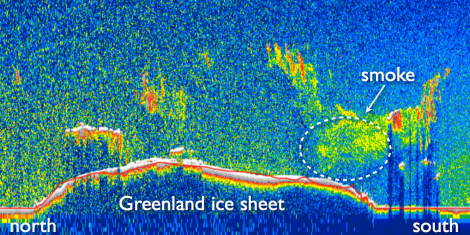Last July, over the course of a week, 97 percent of Greenland’s ice surface melted. The response from scientists can be summarized as: “Um, shit.” Or, by way of a direct quote: “This was so extraordinary that at first I questioned the result: was this real or was it due to a data error?”
It was real. And it’s one of the things that the National Oceanic and Atmospheric Administration’s 2012 Arctic report card cites as an unexpected anomaly in a season full of them.
Researchers now think they know why it happened. Like so much of what’s happening in the Arctic, the melt likely stems from another aspect of climate change: fire.
From the Guardian:
Satellite observations, due to be presented at the annual meeting of the American Geophysical Union on Friday, for the first time tracks smoke and soot particles from tundra wildfires over to Greenland.
Scientists have long known that soot blackens snow and ice, reducing its powers of reflectivity and making it more likely to melt under the sun.
But the satellite records, due to be presented by the Ohio State University geographer Jason Box, go a step further, picking up images of smoke over Greenland at the time of last summer’s extreme melt.
The study, from a team centered at Ohio State’s Byrd Polar Research Center, works backward from the presence of smoke over Greenland (seen above) to possible sources. A series of tundra fires in Alaska and Western Canada and wildfires in Labrador earlier in the summer appear on this June 25 thermal map.

Byrd Polar ResearchClick to embiggen.
Analysis of barometric pressures in the week preceding the start of the melt suggests that winds passing over the areas of wildfire could have carried the smoke seen in the image at top.

Byrd Polar ResearchClick to embiggen.
Along with the smoke came soot, particulate matter of the type that’s also prompting concern over Arctic air travel. Such pollution demonstrably contributes to ice melt.
And, in yet another feedback loop, those tundra fires themselves are exacerbated by and contribute to climate change. From NPR:
Tundra fires have become more common over the past two decades as average temperatures in the Arctic have risen and sea ice has receded. And according to scientists, there has been a marked increase in lightning activity on the North Slope in the last two decades. Warmer temperatures may allow more vegetation to grow — which, in turn, makes it more of a fire risk when lightning strikes.
Normally, the tundra in this region of Alaska, near the Anaktuvuk River, takes up more CO2 from photosynthesis than it gives off every year from natural decomposition. …
Overall, the amount of carbon released — about 2.1 terragrams — is comparable to what comes from forest fires in warmer parts of the planet, according to Dr. Mack. “But what’s surprising to me,” she says, “is that forests have huge trees, and tundra has six-inch-tall, tiny little plants. All that extra carbon is coming from the soil.”
And the extra carbon heads into the atmosphere. In school kids learn about the water cycle. Maybe the carbon circle should be added to the curriculum.
The link between these fires and the Greenland melt is still circumstantial. So the team behind the initial research has launched Dark Snow, a proposed 2013 expedition to Greenland for which they are soliciting contributions. Once there, they plan to analyze the extent to which soot affects the melt.
If they raise the money for the trip, a bit of good news: They can probably leave the ice cleats at home.




